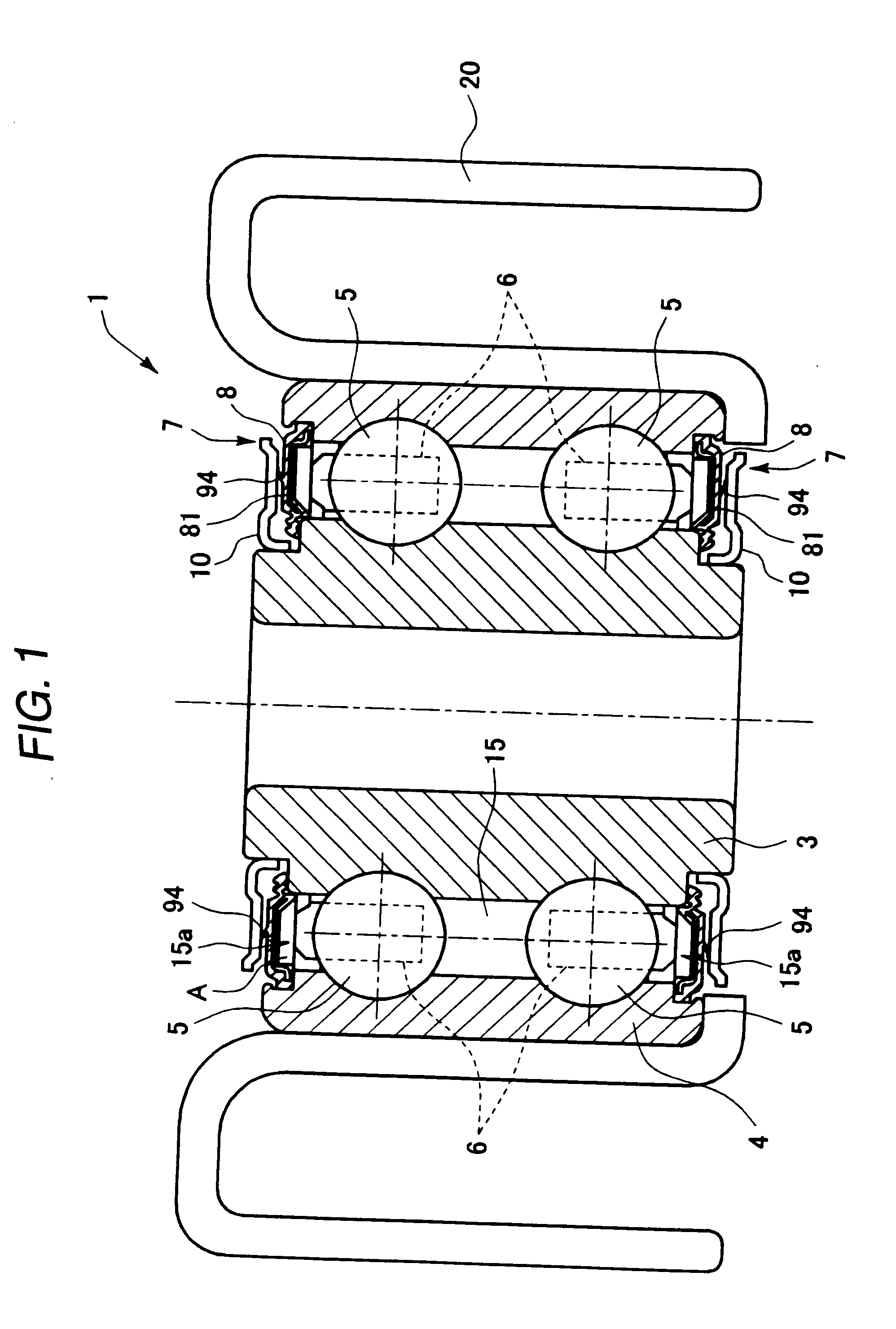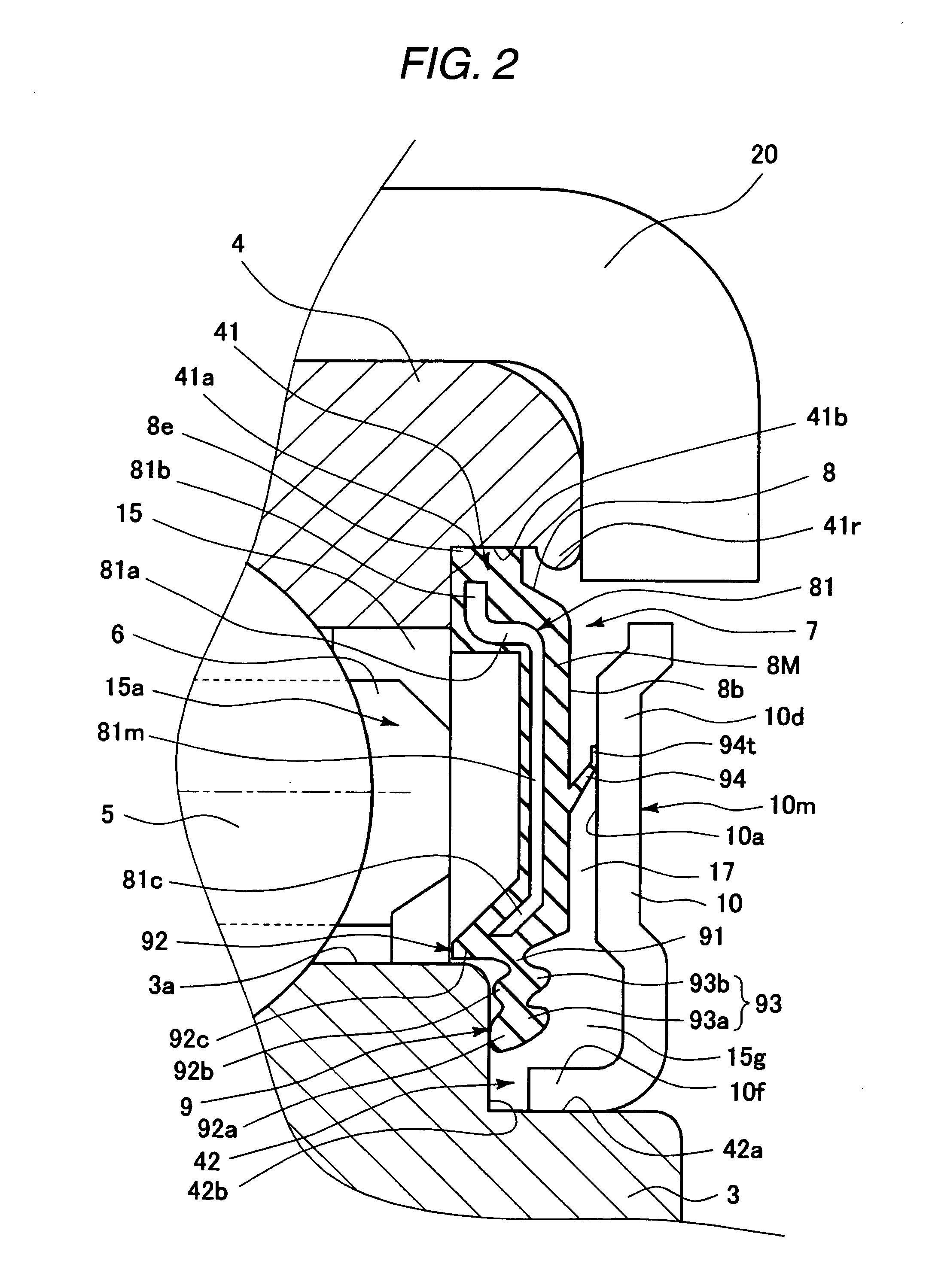Sealing device for bearing
a sealing device and bearing technology, applied in the direction of engine sealing, bearing components, shafts and bearings, etc., can solve the problems of reducing the output of the bearing due to the size reduction, components needing to bear high temperature, and the operating conditions of the automobile have tended to become more severe, so as to achieve the effect of reducing the running torque and high sealing properties
- Summary
- Abstract
- Description
- Claims
- Application Information
AI Technical Summary
Benefits of technology
Problems solved by technology
Method used
Image
Examples
first embodiment
[0074]Hereinafter, embodiments of the invention are described with reference to the accompanying drawings. FIG. 1 is a cross-sectional view illustrating an embodiment of a bearing for an idler pulley, to which a sealing device for a bearing according to a first embodiment of the invention is applied. A bearing 1 is used for rotationally supporting an idler pulley for an automobile. The bearing 1 is formed to be a double row deep groove ball bearing (radial bearing) to be used such that an inner ring 3 is provided at a non-rotating side, and that an outer ring 4 is provided at a rotating side. Balls 5 serving as rolling elements are arranged in a rolling element arranging space 15 formed between the inner ring 3 and the outer ring 4 while the circumferential arrangement integrals thereof are regulated by retainers 6 at the respective rows. A pulley 20 is concentrically fit onto the outer circumferential surface of the outer ring 4.
[0075]In the bearing 1, sealing devices 7 are provide...
second embodiment
[0094]Next, a second embodiment of the invention is described below with reference to FIGS. 13 to 17. The second embodiment differs from the first embodiment mainly in the configuration of the sub-seal lip. Thus, the following description centers on the configuration of the sub-seal lip. Each component common to the first and second embodiments is designated with the same reference numeral. The description of such components is omitted.
[0095]FIG. 13 is an enlarged cross-sectional view illustrating a sealing device portion for a bearing according to a second embodiment of the invention. FIG. 14 is an enlarged cross-sectional view illustrating a sub-seal lip of the sealing device for a bearing illustrating in FIG. 13.
[0096]As illustrated in FIG. 15, an annular branch seal lip 95 is formed at a radially midway position on the inner circumferential surface of the sub-seal lip 94 so as to protrude toward the inner surface of the slinger 10. In a case where the outer ring 4 is in a non-ro...
third embodiment
[0105]Next, a third embodiment of the invention is described below with reference to FIGS. 18 to 22. The third embodiment differs from the first embodiment mainly in the configuration of each of the sub-seal lip and the slinger. Thus, the following description centers on the configuration of the sub-seal lip and the slinger. Each component common to the first and third embodiments is designated with the same reference numeral. The description of such components is omitted.
[0106]As illustrated in FIG. 18, a conical sub-seal lip 94, whose diameter is increased toward the outer side of the bearing in a state, in which the sliding seal portion 8 is not mounted in the rolling bearing 1, as indicated by imaginary lines in FIG. 18, is formed at a radially central portion of the axial base surface 8b of the sliding seal portion 8, which faces the slinger 10, at the outer side of the bearing. Further, in a state in which the sliding seal portion 8 is mounted in the rolling bearing 1, the dis...
PUM
 Login to View More
Login to View More Abstract
Description
Claims
Application Information
 Login to View More
Login to View More - R&D
- Intellectual Property
- Life Sciences
- Materials
- Tech Scout
- Unparalleled Data Quality
- Higher Quality Content
- 60% Fewer Hallucinations
Browse by: Latest US Patents, China's latest patents, Technical Efficacy Thesaurus, Application Domain, Technology Topic, Popular Technical Reports.
© 2025 PatSnap. All rights reserved.Legal|Privacy policy|Modern Slavery Act Transparency Statement|Sitemap|About US| Contact US: help@patsnap.com



